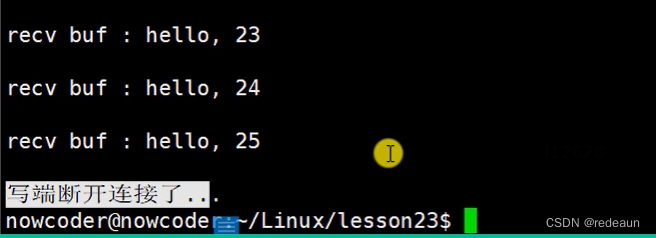读代码:
#include <stdio.h>
#include <sys/types.h>
#include <sys/stat.h>
#include <stdlib.h>
#include <unistd.h>
#include <fcntl.h>
// 从管道中读取数据
int main() {
// 1.打开管道文件
int fd = open("test", O_RDONLY);
if(fd == -1) {
perror("open");
exit(0);
}
// 读数据
while(1) {
char buf[1024] = {0};
int len = read(fd, buf, sizeof(buf));
if(len == 0) {
printf("写端断开连接了...\n");
break;
}
printf("recv buf : %s\n", buf);
}
close(fd);
return 0;
}写代码:
#include <stdio.h>
#include <sys/types.h>
#include <sys/stat.h>
#include <stdlib.h>
#include <unistd.h>
#include <fcntl.h>
#include <string.h>
// 向管道中写数据
/*
有名管道的注意事项:
1.一个为只读而打开一个管道的进程会阻塞,直到另外一个进程为只写打开管道
2.一个为只写而打开一个管道的进程会阻塞,直到另外一个进程为只读打开管道
读管道:
管道中有数据,read返回实际读到的字节数
管道中无数据:
管道写端被全部关闭,read返回0,(相当于读到文件末尾)
写端没有全部被关闭,read阻塞等待
写管道:
管道读端被全部关闭,进行异常终止(收到一个SIGPIPE信号)
管道读端没有全部关闭:
管道已经满了,write会阻塞
管道没有满,write将数据写入,并返回实际写入的字节数。
*/
int main() {
// 1.判断文件是否存在
int ret = access("test", F_OK);
if(ret == -1) {
printf("管道不存在,创建管道\n");
// 2.创建管道文件
ret = mkfifo("test", 0664);
if(ret == -1) {
perror("mkfifo");
exit(0);
}
}
// 3.以只写的方式打开管道
int fd = open("test", O_WRONLY);
if(fd == -1) {
perror("open");
exit(0);
}
// 写数据
for(int i = 0; i < 100; i++) {
char buf[1024];
sprintf(buf, "hello, %d\n", i);
printf("write data : %s\n", buf);
write(fd, buf, strlen(buf));
sleep(1);
}
close(fd);
return 0;
}有名管道
/*
创建fifo文件
1.通过命令: mkfifo 名字
2.通过函数:int mkfifo(const char *pathname, mode_t mode);
#include <sys/types.h>
#include <sys/stat.h>
int mkfifo(const char *pathname, mode_t mode);
参数:
- pathname: 管道名称的路径
- mode: 文件的权限 和 open 的 mode 是一样的
是一个八进制的数
返回值:成功返回0,失败返回-1,并设置错误号
*/
#include <stdio.h>
#include <sys/types.h>
#include <sys/stat.h>
#include <stdlib.h>
#include <unistd.h>
int main() {
// 判断文件是否存在
int ret = access("fifo1", F_OK);
if(ret == -1) {
printf("管道不存在,创建管道\n");
ret = mkfifo("fifo1", 0664);
if(ret == -1) {
perror("mkfifo");
exit(0);
}
}
return 0;
}先运行write文件
 阻塞了,说明没有写入数据
阻塞了,说明没有写入数据
启动read开始写数据
 写端关闭
写端关闭








 本文详细介绍了C语言中如何使用管道进行数据传输,包括读取和写入操作,以及它们在数据交换过程中的阻塞规则。同时讨论了mkfifo函数用于创建有名管道和检查文件存在的access函数。
本文详细介绍了C语言中如何使用管道进行数据传输,包括读取和写入操作,以及它们在数据交换过程中的阻塞规则。同时讨论了mkfifo函数用于创建有名管道和检查文件存在的access函数。














 919
919











 被折叠的 条评论
为什么被折叠?
被折叠的 条评论
为什么被折叠?








